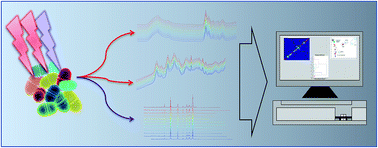Rapid discrimination of Enterococcus faecium strains using phenotypic analytical techniques†
Abstract
Clinical isolates of glycopeptide resistant enterococci (GRE) were used to compare three rapid phenotyping and analytical techniques. Fourier transform infrared (FT-IR) spectroscopy, Raman spectroscopy and matrix-assisted laser desorption/ionization time-of-flight mass spectrometry (MALDI-TOF-MS) were used to classify 35 isolates of Enterococcus faecium representing 12 distinct pulsed-field gel electrophoresis (PFGE) types. The results show that the three analytical techniques provide clear discrimination among enterococci at both the strain and isolate levels. FT-IR and Raman spectroscopic data produced very similar bacterial discrimination, reflected in the Procrustes distance between the datasets (0.2125–0.2411, p < 0.001); however, FT-IR data provided superior prediction accuracy to Raman data with correct classification rates (CCR) of 89% and 69% at the strain level, respectively. MALDI-TOF-MS produced slightly different classification of these enterococci strains also with high CCR (78%). Classification data from the three analytical techniques were consistent with PFGE data especially in the case of isolates identified as unique by PFGE. This study presents phenotypic techniques as a complementary approach to current methods with a potential for high-throughput point-of-care screening enabling rapid and reproducible classification of clinically relevant enterococci.


 Please wait while we load your content...
Please wait while we load your content...